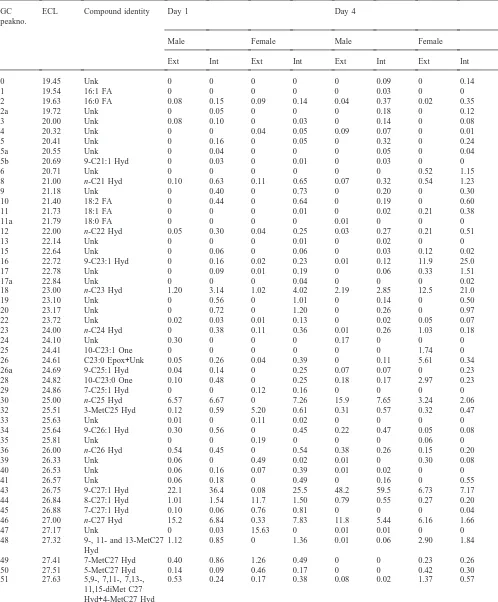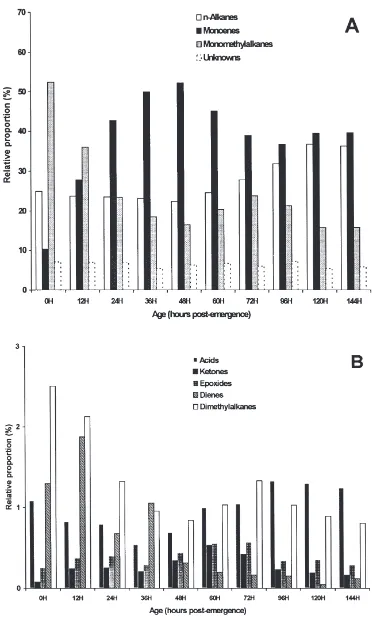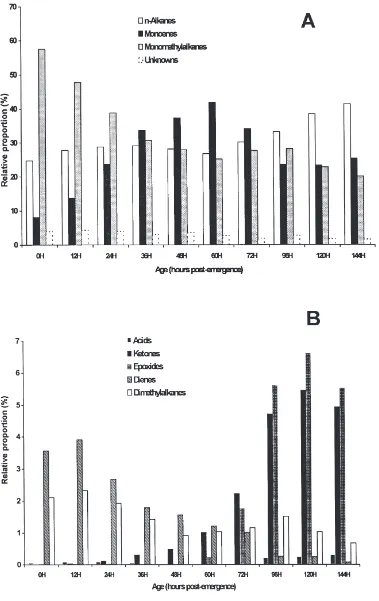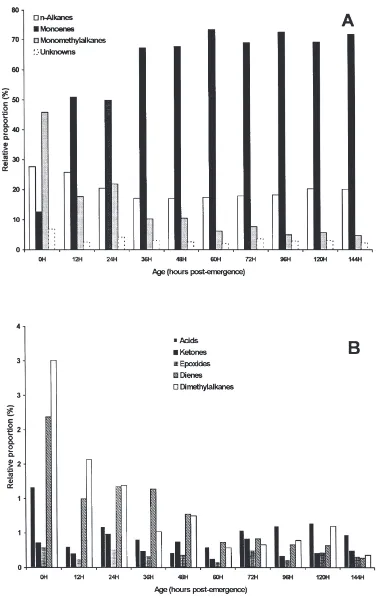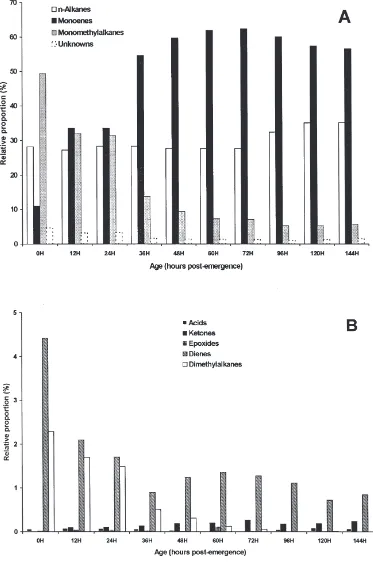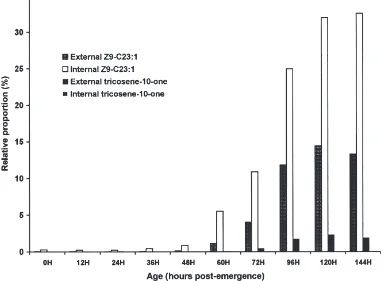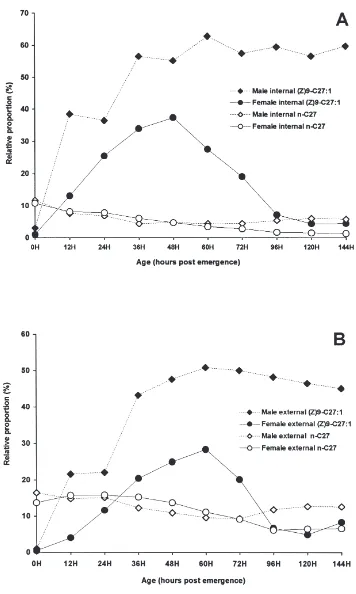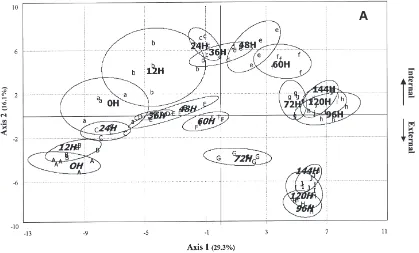www.elsevier.com/locate/ibmb
Effect of age and sex on the production of internal and external
hydrocarbons and pheromones in the housefly, Musca domestica
Shuping Mpuru
a, Gary J. Blomquist
a, Coby Schal
b, Maurice Roux
c, Marilyn Kuenzli
a,
Georges Dusticier
d, Jean-Luc Cle´ment
d, Anne-Genevie`ve Bagne`res
d,*aDepartment of Biochemistry, University of Nevada, Reno, NE 89557-0014, USA
bLaboratoire de Neurobiologie, CNRS-UPR 9024, Communication Chimique, 31 Chemin J. Aiguier, 13402 Marseille, Cedex 9, France cDepartment of Entomology, North Carolina State University, Raleigh, NC 27695-7613, USA
dBiomathe´matiques, service 462, Faculte´ des Sciences de St Jerome, Avenue Normandie-Niemen, 13397 Marseille, Cedex 20, France
Received 19 January 2000; received in revised form 20 April 2000; accepted 26 April 2000
Abstract
The epicuticular and internal waxes of male and female houseflies were examined by capillary gas chromatography-mass spec-trometry at closely timed intervals from emergence until day-6 of adulthood. New components identified included tricosan-10-one, 9,10-epoxyheptacosane, heptacosen-12-one, a series of odd-carbon numbered dienes from C31 to C39, several positional isomers of monoenes including (Z)-9- and 7-pentacosene and a number of methyl- and dimethylalkanes. (Z)-9-tricosene appears in internal lipids prior to appearing on the surface of the insect, suggesting that it is transported in the hemolymph to its site of deposition on the epicuticle. The large increases in the amount of (Z)-9-tricosene in females from day-2 until day-6 is compensated for by a concomitant decrease in heptacosene. The C23 epoxide and ketone only appear in females after the production of (Z)-9-tricosene is induced, and are only abundant in epicuticular waxes, suggesting they are formed after (Z)-9-(Z)-9-tricosene is transported to the cells which are involved in taking them to the surface of the insect. Mathematical analysis indicated that the time shift between internal production and external accumulation in females is more than 24 h. The divergence between male and female lipid production occurs at an early stage, when insects are less than one day old.2001 Published by Elsevier Science Ltd.
Keywords: Cuticular hydrocarbons; Sex-pheromone production; Internal vs external lipids; Selective transport; GC-MS; Mathematical modeling;
Housefly (Musca domestica)
1. Introduction
The sex pheromone of the female house fly, Musca
domestica (L.) consists of (Z)-9-tricosene (Carlson et al.,
1971), cis-9,10-epoxytricosane, (Z)-14-tricosen-10-one (Uebel et al., 1978) and a complex mixture of methylalk-anes (Uebel et al., 1976; Nelson et al., 1981), which function as short range attractants, sex recognition fac-tors, and arrestants (Adams and Holt, 1987). These pher-omone components are modified epicuticular lipids. Extensive work has been performed to understand the shift in the chain lengths of hydrocarbons to produce pheromone at both the endocrine and biochemical levels
* Corresponding author. Tel.:+33-491-16-4589; fax:+ 33-491-22-5850.
E-mail address: [email protected] (A.-G. Bagne`res).
0965-1748/01/$ - see front matter2001 Published by Elsevier Science Ltd. PII: S 0 9 6 5 - 1 7 4 8 ( 0 0 ) 0 0 0 9 8 - 9
(Adams et al. 1984a,b, 1995; Blomquist et al. 1984b, 1987; Tillman-Wall et al., 1992) and to gain an under-standing of the mechanism of hydrocarbon formation (Dillwith and Blomquist, 1982; Dillwith et al. 1981, 1982; Reed et al. 1994, 1995; Mpuru et al., 1996). In maturing female houseflies, ovarian-produced ecdystero-ids cause a modification in hydrocarbon production such that (Z)-9-tricosene becomes a major component (Adams et al., 1984). In addition to accumulating on the surface of the female, a portion of the (Z)-9-tricosene is
con-verted to the corresponding epoxide and ketone
Several studies indicate that hydrocarbons are synthe-sized in oenocytes. The location of oenocytes varies widely among insects (Romer, 1991). Even in insects whose oenocytes are associated with the epidermis, it appears that hydrocarbons are transported through the hemolymph, with lipophorin serving as a shuttle (Chino, 1985; Schal et al., 1998a,b; Sevala et al., 2000). The female housefly begins producing (Z)-9-tricosene about two days after emergence (Dillwith et al., 1983), with relatively large amounts building up internally followed by deposition on the surface of the insect (Adams et al., 1995). Thus, the change in the chain length of the major alkenes, and the presence of oxygenated derivatives of (Z)-9-tricosene (epoxide, ketone) provides a unique opportunity to study the transport of these pheromone components.
Analysis of the cuticular hydrocarbons (Nelson et al., 1981) of male and female insects showed a complex mixture of normal, unsaturated, and methyl-branched components. This analysis was performed with packed columns, which are not as efficient as modern capillary columns. In addition, complete analyses were not perfor-med on the oxygenated cuticular components. In this manuscript, we present a more complete analysis of the hydrocarbons of both male and female insects at various ages and identify a number of new hydrocarbons and oxygenated components. Comparison of the internal waxes with those found on the surface of the insect revealed interesting patterns and provided insight into the location of the synthesis and transport of both hydro-carbons and oxygenated components.
2. Materials and methods
2.1. Insects
Pupae of Fales 1958 strain T-II houseflies were sup-plied by the Biology Section at S.C. Johnson and Sons, Racine, Wisconsin, USA. Males were separated from females within the first six hours post-emergence under carbon dioxide anaesthesia. Houseflies were maintained ad libitum on sucrose and low-fat powdered milk (1:1 w/w) and tap water at 24 to 27°C with a 12h light/12h dark photoperiod. Samples consisted of five replicates of five individuals at different ages, i.e. pupae, pharates, and various times post-emergence for each sex: 0, 12, 24, 36, 48, 60, 72 (3 days), 96 (4 days), 120 (5 days), and 144 (6 days) h. Dead insects were kept at 280°C until thawing for lipid extraction.
2.2. Lipid extraction
External (epicuticular) lipids were extracted from each group of five insects as previously described (Dillwith et al., 1983) except that the three washes were done with
3 ml rather than 10 ml of hexane. Resulting extracts were pooled and concentrated to 1 ml under a gentle stream of nitrogen before addition of 800 ng of n-nonadecane (n-C19) as internal standard prior to GC and GC-MS analysis.
For extraction of internal lipids, insects that had already been washed with hexane to remove external
hydrocarbons, were immersed in 3 ml of
chloroform/methanol (1:2 v/v) for 1 h in an ultrasonic bath with ice, before extracting the internal lipids by the procedure of Bligh and Dyer (1959). The chloroform layer was evaporated under a gentle stream of nitrogen and the lipids taken up in 1 ml hexane to which 800 ng of n-C19 was added as an internal standard.
2.3. Gas chromatography
For quantification, an aliquot of each external and internal sample (2µl with the purge off for 0.5 min) was analysed on a HP-5 column (30 m×0.32 mm ID, 0.25
µm film thickness) on a HP 5890 GC equipped with FID and interfaced with an HP 3393A computing integrator. Oven temperature was held at 150°C for 5 min then increased at a rate of 5°C/min up 320°C, where it was held for 10 min. Both the injector and detector were maintained at 325°C. Helium was the carrier gas. Five replicates for each time and sex were analysed. Peak areas were analysed in Excel spreadsheet and processed as described below.
2.4. Fractionation
Prior to GC-MS analyses, the five replicates for each time-point were pooled into one sample (total of 44 samples). The samples were then fractionated into satu-rated and unsatusatu-rated components on a Silica gel minico-lumn (Aldrich, 60A˚ , 70–230 mesh) that was impregnated with 20% (w/w) silver nitrate (Still et al., 1978; Dillwith et al., 1983). The 44 unsaturated fractions were derivat-ized by DMDS for GC-MS analyses (Francis and Veland, 1981; Carlson et al., 1989).
2.5. Gas chromatography-mass spectrometry (GC-MS)
35 to 600 with about one scan per second, with source temperature held at 240°C and quadrupole at 100°C.
2.6. Quantitative analyses
After introduction into the Excel spreadsheet, each of the 116 peak areas was readjusted using a correcting FID coefficient (Bagne`res et al., 1991a,b). Corrected areas were then expressed as relative proportions (%) and quantities (Q) inµg/mg of insect. Averages and standard deviations were calculated with the five replicate % and Q.
2.7. Principal component analysis
Principal Component Analysis (PCA) was performed with Statgraphics Plus for Windows (v.4.0) and the Uniwin Plus extension (v.3.01). The complete PCA matrix was formed using the 220 samples (ranks) and their 116 peak percentages (columns). Various PCAs were performed including various combinations (e.g. all individuals, only males only females, only internal samples, or only external samples). In the present paper only two analyses will be described in order to illustrate the main divergence (male versus female and internal versus external).
Various data sets were analysed with the principal component method, taking the percentage of each pro-duct as a variable. The principal axes were computed from the correlation matrix. In the following analyses, the coordinates of the observations were considered as new variables, since they are a linear combination of the initial variables.
2.8. Modeling the delay between external and internal hydrocarbon production
Analysis of internal and external production of hydro-carbons showed that points on the main factorial plane (Axes 1 and 2) were ordered along the first axis (F1) according to age. Points corresponding to external samples were shifted toward the negative coordinates, clearly indicating that the same products were observed on the surface of the insect slightly after their internal counterpart. Based on this finding a mathematical expression relating the F1 coordinates to the age of the insects was developed. The logistic function was suc-cessfully adjusted to both external and internal samples:
x5F1(t)5a/[11b Exp(ct)]
Other functions were tried but they did not fit the data better than the logistic function. It was then easy to obtain a graphical estimate of the delay between the two series. The logistic function can be inverting as follows:
t5(1/c)Ln[9a2x)/bx]
It was then possible to calculate the production time for hydrocarbon assemblage summarized by its x= F1-coor-dinate.
2.9. Modeling the divergence between male and female production of hydrocarbon
Plotting of male and female extracts again indicated a time relation between production of hydrocarbons along F1. Points corresponding to male components remained on a positive coordinate on the second axis F2, whereas female points became negative coordinates. Calculations were undertaken to determine exactly when this shift took place. Since female F2-coordinates were found to increase, then decrease and eventually increase again, it was decided to fit a third order polynomial:
x5F2(t)5at3
1bt2
1ct1d
The first optimum of this function was taken as the point of divergence point between males and females. However since the curve representing the fitted poly-nomial did not pass through the observation points cor-rectly, a fourth order polynomial was attempted:
y5F2(t)5at4
1bt3
1ct2
1dt1e
The new fit was tested with respect to the previous one using the Fisher’s F for embedded models:
F5(SS42SS3)/(RSS3/(n2421))
where:
SS3=Sum of squares for the 3rd degree polynomial model;
SS4=Sum of squares for the 4th degree polynomial model;
RSS3=Residual some of squares for the 3rd degree polynomial model;
n=number of observations.
3. Results
3.1. Mass of components
Table 1
Identities of components and percentage contributions of each in lipid extracts from external and internal extracts of day 1 and day 4 male and female houseflies
GC ECL Compound identity Day 1 Day 4
peakno.
Male Female Male Female
Ext Int Ext Int Ext Int Ext Int
0 19.45 Unk 0 0 0 0 0 0.09 0 0.14
8 21.00 n-C21 Hyd 0.10 0.63 0.11 0.65 0.07 0.32 0.54 1.23
9 21.18 Unk 0 0.40 0 0.73 0 0.20 0 0.30
10 21.40 18:2 FA 0 0.44 0 0.64 0 0.19 0 0.60
11 21.73 18:1 FA 0 0 0 0.01 0 0.02 0.21 0.38
11a 21.79 18:0 FA 0 0 0 0 0.01 0 0 0
12 22.00 n-C22 Hyd 0.05 0.30 0.04 0.25 0.03 0.27 0.21 0.51
13 22.14 Unk 0 0 0 0.01 0 0.02 0 0
15 22.64 Unk 0 0.06 0 0.06 0 0.03 0.12 0.02
16 22.72 9-C23:1 Hyd 0 0.16 0.02 0.23 0.01 0.12 11.9 25.0
17 22.78 Unk 0 0.09 0.01 0.19 0 0.06 0.33 1.51
17a 22.84 Unk 0 0 0 0.04 0 0 0 0.02
18 23.00 n-C23 Hyd 1.20 3.14 1.02 4.02 2.19 2.85 12.5 21.0
19 23.10 Unk 0 0.56 0 1.01 0 0.14 0 0.50
28 24.82 10-C23:0 One 0.10 0.48 0 0.25 0.18 0.17 2.97 0.23
29 24.86 7-C25:1 Hyd 0 0 0.12 0.16 0 0 0 0
30 25.00 n-C25 Hyd 6.57 6.67 0 7.26 15.9 7.65 3.24 2.06
32 25.51 3-MetC25 Hyd 0.12 0.59 5.20 0.61 0.31 0.57 0.32 0.47
33 25.63 Unk 0.01 0 0.11 0.02 0 0 0 0
34 25.64 9-C26:1 Hyd 0.30 0.56 0 0.45 0.22 0.47 0.05 0.08
35 25.81 Unk 0 0 0.19 0 0 0 0.06 0
36 26.00 n-C26 Hyd 0.54 0.45 0 0.54 0.38 0.26 0.15 0.20
39 26.33 Unk 0.06 0 0.49 0.02 0.01 0 0.30 0.08
40 26.53 Unk 0.06 0.16 0.07 0.39 0.01 0.02 0 0
41 26.57 Unk 0.06 0.18 0 0.49 0 0.16 0 0.55
43 26.75 9-C27:1 Hyd 22.1 36.4 0.08 25.5 48.2 59.5 6.73 7.17
44 26.84 8-C27:1 Hyd 1.01 1.54 11.7 1.50 0.79 0.55 0.27 0.20
45 26.88 7-C27:1 Hyd 0.10 0.06 0.76 0.81 0 0 0 0.04
46 27.00 n-C27 Hyd 15.2 6.84 0.33 7.83 11.8 5.44 6.16 1.66
47 27.17 Unk 0 0.03 15.63 0 0.01 0.01 0 0
48 27.32 9-, 11- and 13-MetC27 1.12 0.85 0 1.36 0.01 0.06 2.90 1.84
Hyd
49 27.41 7-MetC27 Hyd 0.40 0.86 1.26 0.49 0 0 0.23 0.26
50 27.51 5-MetC27 Hyd 0.14 0.09 0.46 0.17 0 0 0.42 0.30
51 27.63 5,9-, 7,11-, 7,13-, 0.53 0.24 0.17 0.38 0.08 0.02 1.37 0.57
11,15-diMet C27 Hyd+4-MetC27 Hyd
Table 1 (continued)
GC ECL Compound identity Day 1 Day 4
peakno.
Male Female Male Female
Ext Int Ext Int Ext Int Ext Int
52 27.73 3-MetC27 Hyd 0.92 0.78 0.58 0.87 0.68 0.74 1.61 0.96
53 27.81 2-MetC27 Hyd 0.31 0 0.91 0.25 0 0 0.98 0.61
55 28.00 n-C28 Hyd 0.41 0.19 0.34 0.22 0.11 0.09 0.37 0.19
56 28.08 3,7-, 3,9-, 3,11- and 0.15 0.04 0.43 0.18 0 0 1.17 0.87
59 28.63 2-MetC28 Hyd 1.04 0.31 0 0.52 0.57 0.03 0.61 0.14
60 28.67 10-C29:1 Hyd 0.15 0 1.17 0 0.94 0 0 0
61 28.75 9-C29:1 Hyd 6.76 8.51 0 9.98 8.85 11.1 3.18 2.59
62 28.81 8-C29:1 Hyd 0 0 0.14 0 0 0.03 0 0.01
63 28.90 7-C29:1 Hyd 0 0 0 0 0.60 0 0 0
64 29.00 n-C29 Hyd 2.63 0.92 0 1.20 0.63 0.27 5.93 2.56
65 29.33 9-, 11-, 13- and 15- 3.90 2.71 3.18 3.19 0.15 0.26 5.39 3.86 MetC29 Hyd
66 29.43 7-MetC29 Hyd 1.19 0.79 4.49 0.82 0.01 0.02 1.23 1.04
67 29.53 5-MetC29 Hyd 0.22 0.09 1.25 0.08 0 0 0.42 0.31
68 29.65 4-MetC29 Hyd 2.47 1.04 0.22 0.99 0.31 0.07 2.06 1.08
69 29.76 3-MetC29 Hyd 2.22 1.08 2.58 1.23 0.35 0.14 2.34 4.06
70 29.78 Unk 0 0 2.62 0 0 0 0.35 0.25
75 30.62 2-MetC30 Hyd+10- 2.24 0.69 0.07 0.39 0.23 0.08 0.70 0.37
C31:1 Hyd
76 30.66 x,y-C31:2 Hyd 0 0.20 2.37 0.13 0.44 0 0 0
77 30.74 9-C31:1 Hyd 1.47 1.16 0.22 1.91 0.20 0.24 1.14 1.05
78 31.00 n-C31 Hyd 0.79 0.42 1.95 0.52 0.88 0.46 1.27 0.61
79 31.32 9-, 11-, 13- and 15- 5.01 4.40 1.06 4.27 0.53 0.97 1.49 1.50 MetC31 Hyd
80 31.54 7-MetC31 Hyd 0.12 0.08 5.81 0.04 0 0.02 1.05 0
81 31.65 4-MetC31 Hyd 2.07 1.61 2.51 1.31 0.20 0.17 1.0 0.96
82 31.78 3-MetC31 Hyd 1.12 0.65 2.51 0.65 0.38 0.24 1.02 0.62
83 32.00 n-C32 Hyd 0.21 0.13 1.34 0.27 0.05 0.07 0.06 0.16
84 32.28 x,y-C33:2 Hyd 0.55 0.35 0.30 0.35 0.13 0.08 0.11 0.08
85 32.44 Unk 0.42 0.09 0.65 0.21 0.33 0 0 0
86 32.67 9-C33:1 Hyd 1.15 1.06 0.49 1.01 0.08 0.15 0.14 0.16
87 32.80 Unk 0.44 0.49 1.47 1.29 0.36 0.75 0.38 0.36
88 33.00 n-C33 Hyd 0.15 0.18 0.83 0.11 0.21 0.15 0.03 0.02
89 33.28 9-, 11-, 13- and 15- 1.74 1.64 0.20 1.85 0.22 0.49 0.29 0.23 MetC33 Hyd
90 33.58 11,21- and 13,23- 1.28 0.91 2.12 0.90 0.03 0.21 0.31 0.33
4-Table 1 (continued)
GC ECL Compound identity Day 1 Day 4
peakno.
Male Female Male Female
Ext Int Ext Int Ext Int Ext Int
94 34.48 x,y-C35:2 Hyd 0.18 0.10 0.30 0.08 0.12 0 0 0.01
104 36.41 x,y-C37:2 Hyd 0.77 0.52 0.08 0.11 0.34 0.25 0.10 0.01
104a 36.54 x-C37:1 Hyd 0.07 0 1.22 0.57 0 0 0 0.12
µg/mg on day 3. Males had slightly more external hydro-carbons than females at all times studied.
3.2. New components
GC-MS analyses of total waxes from pupae, pharates, and adult males and females from emergence to day 6 showed that saturated and unsaturated hydrocarbons were the most abundant components with lesser amounts of epoxides, ketones and free fatty acids (Table 1). The relative proportion of many components varied consider-ably with age. Table 1 presents data for day 1 and day 4 females and males and for internal and external components. This report confirmed the presence of most components identified in earlier studies (Uebel et al., 1976; Nelson et al., 1981). Only the new findings will be described below.
Free fatty acids accounted for less than 2% of the total components at all times examined. They were more
abundant in internal extractions and consisted of pal-mitic, palmitoleic, stearic, oleic and linoleic acids.
One series of hydrocarbons not detected in this study comprised 4,8-, 4,10- and 4,12-dimethylalkanes with even-numbered carbon chains. In the earlier study, these products had ranged from trace to 0.4% of total hydro-carbons in day 4 females. Strain differences could account for this discrepancy.
identified, but amounts were too small to allow DMDS derivatization and localization of double bonds.
Monomethyl-branched hydrocarbons not reported before included 4-methylheptacosane, 11- and 13-methyloctacosanes, and 13-methyltriacontane,
11-Fig. 4. Effect of age on the relative proportion of major wax components (A) and minor wax components (B) in the external extracts from male houseflies. Lipids were extracted and analysed as described in Materials and methods.
methyltetratriacontane and 15-methylheptatriacontane. New dimethyl branched hydrocarbons included and 13,23-dimethyltritriacontane as well as 9,13-, 11,21-and 11,23-dimethylpentatriacontane.
included tricosan-10-one, heptacosen-12-one (most likely the (Z)-18-isomere) and 9,10-epoxyheptacosane (likely the cis isomer). The saturated C27-ketone must be under one of the nonacosenes (certainly the 8- or 7-). Interestingly, these compounds, as well as
cis-9,10-epoxytricosane and (Z)-14-tricosen-10-one were
observed only in external lipids. Again, the quantities of the unsaturated oxygenated compound were too low (#1%) to allow determination of the double bond.
3.3. Changes with age and sex
Marked changes were observed in internal and exter-nal waxes as houseflies progressively aged. Initially accounting for more than 50% of total components in internal lipid extracts from females (Fig. 1A), monome-thylalkanes decreased until 48 h, then increased slightly at 60 and 72 h and finally decreased to only 15% of the total compounds at day 6. The contribution of n-alkanes increased after 48 h. Monoenes increased from about 10% at emergence to more than 50% at vitellogenesis (48 h) and then decreased down to about 37% at 96 h post-emergence. Throughout the period investigated, unknowns contributed between 4 and 7% of the total compounds. As shown in Fig. 1B, fatty acids, ketones, epoxides, dienes and dimethylalkanes were all present in relatively small amounts in internal lipid extracts from females. The distribution of the external hydrocarbons
Fig. 5. Effect of age on the relative proportion of internal and external (Z)-9 tricosene and tricosen-10-one in female houseflies. Lipids were extracted and analysed as described in Materials and methods.
in females (Fig. 2A) mirrored that of internal hydro-carbons. In contrast, epoxides and ketones, which com-prised less than 0.6% of the internal waxes at all times investigated, became significant components in external waxes, increasing from less than 0.5% at 48 h up to over 5% for both epoxides and ketones at 120 h (Fig. 2B).
nificant amounts externally, suggests that their precursor, (Z)-9-tricosene, is produced in epidermal cells, enters the hemolymph, and then is transported to the surface. A portion of the (Z)-9-tricosene may be converted to the epoxide and ketone during transport to the surface.
The large increases in (Z)-9-tricosene (Fig. 5) in females after 48 h were compensated for by a dramatic decrease in (Z)-9-heptacosene both internally (Fig. 6A) and externally (Fig. 6B). In contrast in males, (Z)-9-hep-tacosene increased from very low levels at emergence and became the major component both internally and externally by 36 h.
3.4. Estimation of the time shift between external and internal lipid production
Principal components analysis of external and internal production of males from emergence to day 6 showed two parallel curves with a time-shift between the two curves. The internal curve lead the external curve differ-ently during development. The first axis (F1, 29.3% of variance) separated the extracts based on age, and the second axis (F2, 16.1%) separated the internal (top) and external (bottom) lipids (Fig. 7A). On day 4 (96H) we can see stagnation on F1 coming with an inverse shift on F2 when adult flies reach maturity.
The data plot shown in Fig. 7B was obtained using the different points on F1, i.e. the axis accounting for
Fig. 7. Principal component analysis (A) of the 116 variables (relative proportions of HCs) for 100 samples from 50 M. domestica females after emergence (50 external lipid extracts: from A to J; and their corresponding 50 internal lipid extracts: from a to j; with 5 individual samples for the 10 different times), ellipses of confidence (per time group) are provided with a risk of 5%. Fitting of a logistic equation expressing the relation between the time (horizontal axis) and the first principal component F1 (vertical axis) with, in (B): real data plot; in (C): fitted curves for internal and external lipid production.
most of the divergence between external and internal lipid production. Fig. 7C shows the fitted curves for internal (xin) and external (xex) production.
The logistic curves were: xin=18.94/(1+2.72
Exp(21.0998 t)), for internal production, and
xex=18.25/(1+9.3 Exp(21.1009 t)) for external
pro-duction. Using a mid-range value of 12 for the x-coordi-nate (note that a constant of 12 was added to all centered coordinates), the following times were obtained: tin=1.41
days and tex=2.62 days.
Thus the time shift between external and internal lipid production was: 2.62 days21.41=1.21 days, i.e. 29 h.
3.5. Estimation of the divergence time between males and females.
Fig. 7. (continued)
x5F2(t)50.279t3
22.223t2
11.774t11.842
with a coefficient of determination R2=0.9152.
To improve this result, fitting to a fourth order poly-nomial was made resulting in the following equation:
y5F2(t)50.0918t4
11.3722t3
26.2646t2
16.65t10.9716
the corresponding coefficient of determination being
R2=0.9418. Since comparison between the two models resulted in a highly significant difference: F=14.116 (for 1 and 45 degrees of freedom), the fourth order poly-nomial equation was chosen. The first derivative of the equation was:
dy/dt520.3672t3
14.1166t2
212.5292t16.65.
This derivative is null for t=0.669 day, i.e. approximately 16 h. This value corresponds to the highest coordinate
in F2, which can be considered as the divergence pro-duction time between the two sexes.
4. Discussion
This study documents a number of additional compo-nents in the waxes of the housefly, all present in small amounts. The absence of pentacosenes in earlier reports implied a tremendous specificity in the enzymes that regulated alkene chain length. Whereas (Z)-9-heptaco-sene predominates in males at all times and in females prior to vitellogenesis, (Z)-9-tricosene predominates in vitellogenic females. In the present study, relatively small amounts of pentacosenes was found at all given time. This clearly argues that regulation of alkene chain length is highly specific but not absolute.
Likewise, the presence of tricosan-10-one, 9,10-epoxyheptacosane and heptacosen-12-one shows that the
cytochrome P450 that normally epoxidizes and
hydroxylates (Z)-9-tricosene to the C23 epoxide and ketone (Ahmad et al., 1987) can also hydroxylate n-tricosane (which is then presumably oxidized to the ketone) and use (Z)-9-heptacosene as substrate. The much larger amounts of C23 epoxide and ketone com-pared to the lower amounts of C27 epoxide and ketone suggest that the specificity is certainly toward the shorter chain alkene.
The change in the chain length of the alkenes from predominantly C27 and longer to predominantly C23 as the female becomes vitellogenic is primarily due to ecdysteroids (Adams et al., 1984; Blomquist et al., 1987) produced in the ovaries. These ecdysteroids apparently repress the synthesis of specific elongases (Tillman-Wall et al., 1992) that elongate monoenoic fatty acyl-CoAs of 24 carbons to 28 carbons and longer. This results in the accumulation of 24:1-CoAs, which are then converted to (Z)-9-tricosene by a two-step reaction involving a cytochrome P450 (Reed et al. 1994, 1995; Mpuru et al., 1996).
Fig. 8. Principal component analysis (A) of the 116 variables (relative proportions of HCs) for 100 internal lipid extracts from 50 males (5 individuals for the 10 times) and 50 females (5 individuals for the 10 times) of M. domestica), ellipses of confidence (per time group) are provided with a risk of 5%. In B: Fitting of a 4th order polynomial (y) expressing the relation between the time (horizontal axis) and the second principal component F2 (vertical axis).
The role of hemolymph in transporting cuticular hydrocarbons and hydrocarbon pheromones in insects has only recently become fully appreciated. Older mod-els of hydrocarbon formation showed epidermal cells (oenocytes) synthesizing and transporting hydrocarbons directly to the surface (Hadley, 1984). In the housefly, the role of hemolymph is most clearly seen when (Z)-9-tricosene production is initiated. (Z)-(Z)-9-tricosene first accumulates in the hemolymph, and then after a number of hours, is observed on the surface of the insect. The
result of the modeling of the delay between internal and external composition gave a good timing for transport from the oenocytes and their transport onto the epicuti-cle. Surprisingly, the delay is longer than expected. More than 24 h are necessary for transportation and regulation of that transport. The delay appears to decrease with age, which probably means that the biosynthesis stops after the vitellogenesis.
accumulate on the surface. This finding suggests that hydrocarbon in the hemolymph is taken by epidermal cells. The cytochrome P450 that converts the (Z)-9-trico-sene to the epoxide and ketone (Ahmad et al., 1987) is probably located in these cells, where a portion of the alkene is metabolized to the epoxide and ketone as they pass through to the surface of the insect. These data also suggest that the synthesis of (Z)-9-tricosene occurs in cells different from those that convert the alkene to the epoxide and ketone. The possibility that oxidative pro-cesses occur on the surface of the insect appears unlikely since microsomal cytochrome P450s have been impli-cated in the conversion of (Z)9-23:1 Hyd to epoxide.
Another clear example of the transport of cuticular hydrocarbon and pheromone in the hemolymph is the tiger moth, Holomelina aurantiaca. The adult female simultaneously synthesizes short-chain hydrocarbon that serve as volatile sex pheromone components and long-chain hydrocarbons that are deposited on the epicuticle (Schal et al., 1998a). All hydrocarbons are loaded onto a hemolymph high-density lipophorin. 2-Methylheptade-cane and related pheromone homologs of similar chain length are specifically deposited into pheromone glands that open and emit the pheromone near the ovipositor. Long-chain hydrocarbons, on the other hand, appear on the epicuticular surface. In this insect the profile of “internal” hydrocarbon is different from “hemolymph” hydrocarbon because specific hydrocarbons are seques-tered in an internal gland. This, however, is much differ-ent from most reports, which show that internal and epicuticular hydrocarbons are relatively similar (Schal et al., 1998b). In contrast to the “spatial” (tissue) dis-sociation of unique hydrocarbons in the tiger moth, we see a “temporal” dissociation of unique hydrocarbons in the female housefly, as they first appear in the hemo-lymph and later on the surface of the insect.
Acknowledgements
This work was supported by grants from the National Science Foundation (IBN-9630916) and the Fondation Simone et Cino Del Duca, and by a contribution of the Nevada Agriculture Experiment Station (USA). We thank Pascal Torregrossa and Gerald Milioti for their assistance.
References
Adams, T.S., Holt, G.G., 1987. Effect of pheromone components when applied to different models on male sexual behavior in the housefly
Musca domestica. J. Insect Physiol. 33, 9–18.
Adams, T.S., Holt, G.G., Blomquist, G.J., 1984a. Endocrine control of pheromone biosynthesis and mating behavior in the housefly,
Musca domestica. In: Engels, E.W. (Ed.), Advances in Invertebrate
Reproduction, third ed. Elsevier, Amsterdam, pp. 441–456.
Adams, T.S., Dillwith, J.W., Blomquist, G.J., 1984b. The role of 20-hydroxyecdysone in housefly sex pheromone biosynthesis. J. Insect Physiol. 30, 287–294.
Adams, T.S., Nelson, D.R., Blomquist, G.J., 1995. Effect of endocrine organs and hormones on (Z)-9-tricosene levels in the internal and external lipids of female houseflies Musca domestica. J. Insect Phy-siol. 41, 609–615.
Ahmad, S., Kirkland, K.E., Blomquist, G.J., 1987. Evidence for a sex pheromone metabolizing cytochrome P-450 monooxygenase in the housefly. Arch. Insect Biochem. Physiol. 6, 121–140.
Bagne`res, A.-G., Errard, C., Mulheim, C., Joulie, C., Lange, C., 1991a. Induced mimicry of colony odors in ants. J. Chem. Ecol. 17, 1642–1664.
Bagne`res, A.-G., Killian, A., Cle´ment, J.-L., Lange, C., 1991b. Inter-specific recognition among termites of the genus Reticulitermes: evidence for a role of the cuticular hydrocarbons. J. Chem. Ecol. 17, 2397–2420.
Bligh, E.G., Dyer, W.J., 1959. A rapid method of total lipid extraction and purification. Can. J. Biochem. Physiol. 39, 911–917. Blomquist, G.J., Dillwith, J.W., Pomonis, J.G., 1984a. Sex pheromone
of the housefly: Metabolism of (Z)-9-tricosene to (Z)-9,10-epoxy-tricosane and (Z)-14-tricosen-10-one. Insect Biochem. 14, 279– 284.
Blomquist, G.J., Adams, T.S., Dillwith, J.W., 1984b. Induction of female sex pheromone production in male houseflies by ovarian implants or 20-hydroxyecdysone. J. Insect Physiol. 30, 295–302. Blomquist, G.J., Dillwith, J.W., Adams, T.S., 1987. Biosynthesis and
endocrine regulation of sex pheromone production in Diptera. In: Prestwich, G.D., Blomquist, G.J. (Eds.), Pheromone Biochemistry. Academic Press, New York, pp. 217–250.
Blomquist, G.J., Adams, T.S., Halarnkar, P.P., Gu, P., Mackay, M.E., Brown, L., 1992. Ecdysteroid induction of sex pheromone biosynthesis in the housefly, Musca domestica—Are other factors involved? Insect Physiol. 38, 309–318.
Blomquist, G.J., Tillman, J.A., Reed, J.R., Gu, P., Vanderwel, D., Choi, S., Reitz, R.C., 1995. Regulation of enzymatic activity involved in sex pheromone production in the housefly Musca
dom-estica. Insect Biochem. Molec. Biol. 25, 751–757.
Carlson, D.A., Mayer, M.S., Sillhacek, D.L., James, J.D., Beroza, M., Bierl, B.A., 1971. Sex attractant pheromone of the housefly: Iso-lation, identification and synthesis. Science 174, 76–78.
Carlson, D.A., Roan, C.S., Yost, R.A., Hector, J., 1989. Dimethyl dis-ulfide derivatives of long chian alkenes, alkadienes and alkatrienes for gas chromatography/mass spectrometry. Analyt. Chem. 61, 1564–1571.
Chino, H., 1985. Lipid transport: biochemistry of hemolymph lipopho-rin. In: Kerkut, G.A., Gilbert, L.I. (Eds.), Comprehensive Insect Physiology, Biochemistry and Pharmacology, vol. 10. Pergamon Press, Oxford, pp. 115–135.
Dillwith, J.W., Blomquist, G.J., 1982. Site of sex pheromone biosynth-esis in the female housefly Musca domestica. Experientia 38, 471–473.
Dillwith, J.W., Blomquist, G.J., Nelson, D.R., 1981. Biosynthesis of the hydrocarbon components of the sex pheromone of the housefly
Musca domestica L. Insect Biochem. 1, 247–253.
Dillwith, J.W., Nelson, J.H., Pomonis, J.G., Nelson, D.R., Blomquist, G.J., 1982. A 13C-NMR study of methyl-branched hydrocarbon biosynthesis in the housefly. J. Biol. Chem. 257, 11305–11314. Dillwith, J.W., Adams, T.S., Blomquist, G.J., 1983. Correlation of
housefly sex pheromone production with ovarian development. J. Insect Physiol. 29, 377–386.
of double-bond positions in linear alkenes. J. Chromat. 219, 379–384.
Hadley, N.F., 1984. Cuticle: biochemistry. In: Bereiter-Hahn, J., Matoltsy, A.G., Richards, K.S. (Eds.), Biology of the Integument. Springer-Verlag, Berlin, pp. 685–702.
Mpuru, S., Reed, J.R., Reitz, R.C., Blomquist, G.J., 1996. Mechanism of hydrocarbon biosynthesis from aldehyde in selected insect spec-ies: requirement for O2and NADPH and carbonyl group released as CO2. Insect Biochem. Molec. Biol. 26, 203–208.
Nelson, D.R., Dillwith, J.W., Blomquist, G.J., 1981. Cuticular hydro-carbons of the house fly Musca domestica. Insect Biochem. 11, 187–197.
Paulmier, I., Bagne`res, A.-G., Afonso, C.M.M., Dusticier, G., Rivie`re, G., Cle´ment, J.-L., 1999. Alkenes as a sexual pheromone in the alfalfa leaf-cutter bee Megachile rotundata. J. Chem. Ecol. 25, 471–490.
Reed, J.R., Hernandes, P., Blomquist, G.J., Feyereisen, R., Reitz, R.C., 1996. Hydrocarbon biosynthesis in the housefly, Musca domestica: substrate specificity and cofactor requirement of P450hyd. Insect Biochem. Molec. Biol. 26, 267–276.
Reed, J.R., Vanderwel, D., Choi, S., Pomonis, J.G., Reitz, R.C., Blomquist, G.J., 1994. Unusual mechanism of hydrocarbon forma-tion in the housefly: Cytochrome P450 converts aldehyde to the sex pheromone component (Z)-9-tricosene and CO2. Proc. Natl. Acad. Sci. USA 91, 10000–10004.
Reed, J.R., Quilici, D.R., Blomquist, G.J., Reitz, R.C., 1995. Proposed mechanism for the cytochrome-P450 catalyzed conversion of alde-hydes to hydrocarbons in the housefly Musca domestica. Biochem-istry 34, 26221–26227.
Romer, F., 1991. The oenocytes of insects: differentiation, changes during molting, and their possible involvement in the secretion of molting hormone. In: Gupta, A.P. (Ed.), Morphogenetic Hormones of Arthropods: Roles in Histogenesis, Organogenesis, and Morpho-genesis. Rutgers University Press, New Brunswick, NJ, pp. 542– 567.
Schal, C., Sevala, V.L., Carde´, R.T., 1998a. Novel and highly specific
transport of a volatile sex pheromone by hemolymph lipophorin in moths. Naturwissenschaften 85, 339–342.
Schal, C., Sevala, V.L., Young, H., Bachmann, J.A.S., 1998b. Syn-thesis and transport of hydrocarbons: Cuticle and ovary as target tissues. Amer. Zool. 38, 382–393.
Sevala, V., Bagne`res, A.-G., Kuenzli, M.E., Blomquist, G.J., Schal, C., 2000. Cuticular hydrocarbons of the termite Zootermopsis
neva-densis (Hagen): caste differences and role of lipophorin in transport
of hydrocarbon and hydrocarbon metabolites. J. Chem. Ecol. 26, 765–790.
Still, W.C., Kahn, M., Mitra, A., 1978. Rapid chromatographic tech-nique for preparative separations with moderate resolution. J. Org. Chem. 43, 2923–2925.
Tillman-Wall, J.A., Vanderwel, D., Kuenzli, M.E., Reitz, R.C., Blomquist, G.J., 1992. Regulation of sex pheromone biosynthesis in the housefly, Musca domestica: relative contribution of the elongation and reductive step. Arch. Biochem. Biophys. 299, 92– 99.
Trabalon, M., Campan, M., Baehr, J.-C., Mauchamp, B., 1987. In vitro biosynthesis of juvenile hormone III by the corpora allata of
Calli-phora vomitoria and its role in ovarian maturation and sexual
receptivity. Experientia 43, 1113–1115.
Trabalon, M., Campan, M., Cle´ment, J.-L., Lange, C., Miquel, M.-T., 1992. Cuticular hydrocarbons of Calliphora vomitoria (Diptera): Relation to age and sex. Gen. Comp. Endocrinol. 85, 208–216. Trabalon, M., Campan, M., Hartmann, N., Baehr, J.-C., Porcheron, P.,
Cle´ment, J.-L., 1994. Effects of allatectomy and ovariectomy on cuticular hydrocarbons in Calliphora vomitoria (Diptera). Arch. Insect Biochem. Physiol. 25, 363–373.
Uebel, E.C., Sonnet, P.E., Miller, R.W., 1976. House fly sex phero-mone: Enhancement of mating strike activity by combination of (Z)-9-tricosene with branched saturated hydrocarbons. Environ. Entomol. 5, 905–908.
